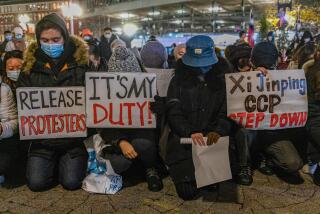Book on British woman’s slaying revisits China in 1930s
- Share via
BEIJING — The Fox Tower in southeastern Beijing, a centuries-old fortress-like building with deep-set red windows and curving eaves, has stood through the fall of the Qing Dynasty, the reign of Mao Tse-tung and the crush of urban development.
But for 45-year-old Sinologist Paul French, one historical event stands out above the rest: One morning in 1937, the mutilated corpse of a 19-year-old British woman was found at the base of the tower, her organs removed with surgical precision.
Although the Jack the Ripper-style slaying of Pamela Werner shocked Beijing’s foreign population, the case quickly faded from headlines. Japanese troops occupied the city five months later, and police abandoned their investigation. The killer was never found.
In his true-crime tale, “Midnight in Peking,” French tries to solve the mystery. By weaving together information from British and Chinese historical archives, old newspaper clippings and interviews with Werner’s now-elderly former classmates, French paints an intimate portrait of 1930s Beijing, a city of opium dens, refugees and warlords steeped in terror of the impending invasion.
“This happens to be just one murder of one 19-year-old foreign girl,” he said. “But for a brief moment, it comes to symbolize that fear and terror and inevitability of what’s going to happen.”
In today’s Beijing, French’s portrait feels surprisingly germane. The specter of political and economic turmoil hangs over the capital, where a dramatic wealth gap is clearly on display: Migrant worker slums pepper the city’s outskirts, and BMWs cruise alongside rusty auto-rickshaws on freshly paved freeways.
And the killing of a British citizen in China is once again in the news: A high-powered political wife is suspected in the death of businessman Neil Heywood late last year in the city of Chongqing, a killing that may have triggered the nation’s biggest political shake-up in decades, exposing corruption in the highest ranks of the Communist Party elite.
French occasionally takes history buffs for hourlong walks from the Ming Dynasty-era alley where the Werner family once lived, around the Fox Tower, and through the former Legation Quarter, once a two-acre compound housing embassies and residences of the city’s well-heeled foreign population.
Werner lived with her adoptive father, a retired British diplomat with a misanthropic streak, but spent most of her time at boarding school in nearby Tianjin. A black-and-white studio portrait shows a slim, blond young woman in a tight-fitting black dress, her expression a mixture of melancholy, self-assurance and budding maturity.
The case fascinates French, who came to China for the first time in 1987 after studying economics and history in London. He has lived in Shanghai for more than two decades, where he runs a market research firm called Access Asia and writes nonfiction books about Asian history.
Much of “Midnight in Peking” centers on the police investigation — a joint effort by a Chinese police chief and a detective from Scotland Yard — and a quest by Werner’s father to find the killer after the police stopped trying.
During the walk, French uncovered relics of Werner’s time tucked among Beijing’s skyscrapers and freeways.
Armor Factory Alley, home to the Werner family and a cast of other intrepid foreigners (including Edgar Snow, the first foreign journalist to interview Mao), is now lined with crumbling brick homes concealed behind boxy concrete additions.
Snow’s spacious compound is now inhabited by 40 to 50 families. Its central courtyard, where a tennis court once stood, is a warren of ramshackle rooms and narrow hallways.
In the 1930s, the Legation Quarter “was Europe in miniature, with European road names and electric streetlights,” home to a German hospital, a French jewelry shop and an English tailor, French wrote in his book.
In the intervening years, many traces of the area’s foreign history have been glossed over or scrubbed clean. The former American Legation is now an upscale dining complex. An old French post office is now a Sichuan restaurant. The former Japanese Legation is occupied by the Beijing municipal government.
Some legation buildings have been converted to shadowy government offices, their gates patrolled by straight-backed security guards in olive green uniforms. Police vans sit idle on the empty tree-lined streets.
French shook his head over the lack of pedestrians.
“If you look in the middle of New York and there’s a square mile of Qing Dynasty architecture, people would be interested in that,” he said.
DespiteChina’sheadlong rush to demolish the past, French has no intention of leaving.
“It’s a great story,” he said. “Don’t you want to find out how this ends?”
Kaiman is a special correspondent.
More to Read
Sign up for Essential California
The most important California stories and recommendations in your inbox every morning.
You may occasionally receive promotional content from the Los Angeles Times.













